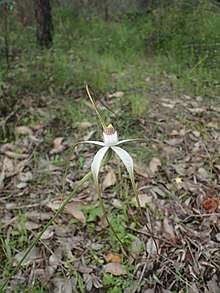Caladenia longicauda subsp. merrittii
Caladenia longicauda subsp. merrittii, commonly known as Merritt's white spider orchid, is a plant in the orchid family Orchidaceae and is endemic to the south-west of Western Australia. It has a single hairy leaf and up to three large, mainly white flowers with very long, drooping lateral sepals and petals, and a white broad labellum with relatively short labellum teeth. It is one of the largest spider orchids.
| Merritt's white spider orchid | |
|---|---|
 | |
| Caladenia longicauda subsp. merrittii near the Blackwood River | |
| Scientific classification | |
| Kingdom: | Plantae |
| Clade: | Tracheophytes |
| Clade: | Angiosperms |
| Clade: | Monocots |
| Order: | Asparagales |
| Family: | Orchidaceae |
| Subfamily: | Orchidoideae |
| Tribe: | Diurideae |
| Genus: | Caladenia |
| Species: | |
| Subspecies: | C. l. subsp. merrittii |
| Trinomial name | |
| Caladenia longicauda subsp. merrittii | |
| Synonyms[1] | |
|
Arachnorchis longicauda subsp.merrittii (Hopper & A.P.Br.) D.L.Jones & M.A.Clem. | |
Description
Caladenia longicauda subsp. merrittii is a terrestrial, perennial, deciduous, herb with an underground tuber and a single hairy leaf, 120–200 mm (5–8 in) long and 6–10 mm (0.2–0.4 in) wide. Up to three, mainly white flowers 180–250 mm (7–10 in) long and 120–180 mm (5–7 in) wide are borne on a spike 300–450 mm (10–20 in) tall. The dorsal sepal is erect and the dorsal and lateral sepals are 94–150 mm (4–6 in) long and 3–6 mm (0.1–0.2 in) wide with long drooping tips. The petals are 90–110 mm (3.5–4.3 in) long and 2–4 mm (0.08–0.2 in) wide. The labellum is white, 20–28 mm (0.8–1 in) long, 9–11 mm (0.35–0.43 in) wide with narrow teeth, shorter than those in other subspecies, along its edges. There are four or more rows of pale red calli in the centre of the labellum. Flowering occurs from September to October.[2][3][4][5]
Taxonomy and naming
Caladenia longicauda was first formally described by John Lindley in 1840 and the description was published in A Sketch of the Vegetation of the Swan River Colony.[6] In 2001 Stephen Hopper and Andrew Brown described eleven subspecies, including subspecies merrittii and the descriptions were published in Nuytsia.[1] The subspecies name (merrittii) honours an orchid enthusiast, Wayne Merritt, who was one of the first to recognise this orchid as a new subspecies.[3]
Distribution and habitat
Merritt's white spider orchid mainly occurs between Augusta, Margaret River and Nannup in the Jarrah Forest and Warren biogeographic regions where it grows in jarrah forest.[2][3][4][7]
Conservation
Caladenia longicauda subsp. merrittii is classified as "not threatened" by the Western Australian Government Department of Parks and Wildlife.[7]
References
- "Caladenia longicauda subsp. merrittii". APNI. Retrieved 17 February 2017.
- Jones, David L. (2006). A complete guide to native orchids of Australia including the island territories. Frenchs Forest, N.S.W.: New Holland. p. 64. ISBN 1877069124.
- Brown, Andrew; Dundas, Pat; Dixon, Kingsley; Hopper, Stephen (2008). Orchids of Western Australia. Crawley, Western Australia: University of Western Australia Press. p. 87. ISBN 9780980296457.
- Hoffman, Noel; Brown, Andrew (2011). Orchids of South-West Australia (3rd ed.). Gooseberry Hill: Noel Hoffman. p. 101. ISBN 9780646562322.
- Brown, Andrew P.; Brockman, Garry (2015). "New taxa of Caladenia (Orchidaceae) from south-west Western Australia". Nuytsia. 25: 106–107.
- "Caladenia longicauda". APNI. Retrieved 17 February 2017.
- "Caladenia longicauda subsp. merrittii". FloraBase. Western Australian Government Department of Parks and Wildlife.